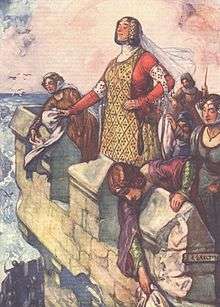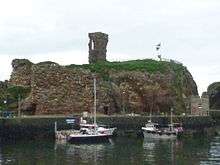Agnes, Countess of Dunbar
| Agnes Dunbar | |
|---|---|
 Black Agnes, as depicted in a children's history book from 1906 | |
| Spouse(s) | Patrick, Earl of March |
| Father | Thomas Randolph, Earl of Moray |
| Mother | Isabel Stewart of Bonkyll |
| Born | c.1312 |
| Died | 1369 (Aged about 57) |
| Buried | Mordington, Berwickshire |
Agnes, Countess of Dunbar and March (née Randolph; c. 1312–1369), known as Black Agnes for her dark hair and eyes, and sallow complexion, was the wife of Patrick, 9th Earl of Dunbar and March. She is buried in the vault near Mordington House.
She was the daughter of Thomas Randolph, Earl of Moray, nephew and companion-in-arms of Robert the Bruce, and Moray's wife, Isabel Stewart, herself a daughter of John Stewart of Bonkyll.[1] Agnes became renowned for her heroic defence of Dunbar Castle in East Lothian against an English siege led by William Montagu, 1st Earl of Salisbury, which began on 13 January 1338 and ended on 10 June the same year.
The Siege of Dunbar

In 1338, when Patrick Dunbar was away, the English laid siege to Dunbar Castle, where Lady Agnes was in residence with her servants and a few guards. However, she was determined not to surrender the fortress, and is said to have declared:
"Of Scotland's King I haud my house, I pay him meat and fee, And I will keep my gude auld house, while my house will keep me."[2]
Women were known to take charge of castle or manor business while the husband was away in the Middle Ages, but the stand of Lady Agnes is one of the best remembered instances. Salisbury’s first attempt at taking the castle centered on catapulting huge rocks and lead shot against the ramparts, but this was met with disdain by Lady Agnes, who had one of her ladies-in-waiting dust off the ramparts with her kerchief.[3]
The English were employing an enormous siege tower called a sow in an attempt to storm the castle, but the countess simply advised Salisbury that he should “take good care of his sow, for she would soon cast her pigs, meaning his men, within the fortress.” She then ordered that a boulder, which had been heaved on them earlier, be thrown down from the battlements and crushed Salisbury’s sow to pieces.[4]
When one of the Scottish archers struck an English soldier standing next to Salisbury, the earl cried out, “There comes one of my lady’s tire pins; Agnes’s love shafts go straight to the heart.”[5]
Unable to make progress through arms, Salisbury turned to craft. He bribed the Scotsman who guarded the principal entrance, advising him to leave the gate unlocked or to leave it in such a manner that the English could easily break in. However, the Scotsman, though he took the Englishman’s money, reported the stratagem to Agnes, so she was ready for the English when they made entry. Though Salisbury was in the lead, one of his men pushed past him just at the moment when Agnes’s men lowered the portcullis, separating him from the others. Agnes, of course, had meant to trap Salisbury, but she moved from stratagem to taunt, hollering at the earl, " Farewell, Montague, I intended that you should have supped with us, and assist us in defending the Castle against the English."[6]
At one point, having captured Agnes’s brother, John Randolph, 3rd Earl of Moray, the English threw a rope around his neck and threatened to hang him if Agnes did not surrender the castle. However, she merely responded that his death would only benefit her, as she would inherit his earldom. She was not actually in line for the earldom, so either she was taking a serious gamble with her brother’s life or the story is a later embellishment.[7]
As his last resort, Salisbury decided to isolate the castle from the roads and any communication with the outside world in an effort to starve the Countess and her garrison, but Ramsay of Dalhousie, who had earned a reputation for being a constant thorn in the English king’s side, got wind of what the English were trying and moved from Edinburgh to the coast with forty men. Appropriating some boats, Ramsay and his company approached the castle by sea and entered the postern next to the sea. Charging out of the castle, the Scotsmen surprised Salisbury’s advance guard and pushed them all the way back to their camp.[8]
Five months had passed since the English had come to Dunbar. Salisbury admitted defeat and lifted the siege on 10 June 1338 but the triumph of a Scotswoman over an English army lives on in a ballad, which puts these words in Salisbury’s mouth:
"Cam I early, cam I late, I found Agnes at the gate."[9]
Family
Some accounts describe her as Countess of Moray, on the assumption that she inherited the earldom when her brother John was killed at the Battle of Neville's Cross in 1346.[10] However, the earldom actually reverted to the crown.[11] However, in 1371/2, Agnes's nephew, John Dunbar, was created Earl of Moray by Robert II, his father-in-law.[12]
It seems that there were no surviving children of the marriage between Agnes and the Earl. Their estates were left to children of the marriage between the Earl's cousin John de Dunbar of Derchester and Birkynside and his wife, Isobel Randolph, Agnes's younger sister.
The three nephews were:
- George, Earl of Dunbar and March
- John Dunbar, Earl of Moray
- Sir Patrick de Dunbar, of Beil
She also had a ward, Agnes Dunbar, who became mistress of King David II.
References
- ↑ Balfour Paul, Scots Peerage (1904) vol vi, pp294-295
- ↑ Kristen, Clive (2012). Ghost Trails of Edinburgh and the Borders. Luton, Beds: Andrews UK. Retrieved 26 Aug 2016.
- ↑ Kristen. Ghost Trails.
- ↑ Lawson, John Parker (1849). Historical Tales of the Wars of Scotland and of the Border Raids, Forays, and Conflicts. Edinburgh. p. 1:89. Retrieved 26 Aug 2016.
- ↑ Lawson. Historical Tales. 1:89.
- ↑ Lawson. Historical Tales. p. 1:90.
- ↑ Kristen. Ghost Trails.
- ↑ Lawson. Historical Tales. p. 1:90-91.
- ↑ Kristen. Ghost Trails.
- ↑ Stodart, R.R. (1881). Scottish arms: Being a Collection of Armorial Bearings, A.D. 1370-1678. Edinburgh. p. 19. Retrieved 26 Aug 2016.
- ↑ Cokayne, George Edward (1893). Complete Peerage of England, Scotland, Ireland, Great Britain and the United Kingdom. London. p. 5:359. Retrieved 26 Aug 2016.
- ↑ Cokayne. Complete Peerage. p. 5:360.
Bibliography
- Chicago, Judy. (2007). The Dinner Party: From Creation to Preservation. London: Merrell. ISBN 1-85894-370-1.